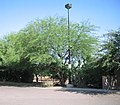Senegalia berlandieri
Senegalia berlandieri, commonly known as Guajillo, is a species of flowering plant in the legume family, Fabaceae. It is native to the southwestern United States and northern Mexico, thriving in arid and semi-arid climates. This species is notable for its adaptability to harsh environments, making it an important component of the ecosystems in which it resides.
Description[edit]
Senegalia berlandieri is a small to medium-sized tree or shrub, reaching heights of up to 10 meters. It has a distinctive appearance with feathery, finely divided leaves, which are a characteristic of many members of the Acacia genus. The plant produces clusters of small, yellow flowers, which are followed by flat, elongated seed pods. The bark is dark and can be deeply fissured.
Habitat and Distribution[edit]
The natural habitat of Senegalia berlandieri includes the Chihuahuan Desert and other arid regions in the southwestern United States and northern Mexico. It is well-adapted to survive in environments with low water availability, high temperatures, and poor soil conditions.
Ecological Role[edit]
Senegalia berlandieri plays a crucial role in its ecosystem, providing food and habitat for various wildlife species. Its flowers are a source of nectar for bees and other pollinators, while the seed pods are consumed by a variety of animals, including birds and small mammals. The tree also serves as a host plant for several butterfly species.
Uses[edit]
Historically, Senegalia berlandieri has been used by indigenous peoples for a variety of purposes. The wood is hard and durable, making it suitable for construction and tool-making. The bark and leaves have been used in traditional medicine for their purported health benefits. Additionally, the plant is sometimes used as a forage crop for livestock due to its nutritional content.
Chemical Composition[edit]
Senegalia berlandieri contains a number of bioactive compounds, including alkaloids that have been the subject of scientific research. These compounds have been studied for their potential pharmacological properties, including analgesic and anti-inflammatory effects.
Conservation Status[edit]
While Senegalia berlandieri is not currently listed as endangered, its habitat is threatened by human activities such as land development and overgrazing. Conservation efforts are necessary to ensure the survival of this species and the preservation of its ecosystem.
See Also[edit]
-
Acacia berlandieri branch
-
Acacia berlandieri flowers
-
Acacia berlandieri habit
-
Acacia berlandieri bark
-
Acacia berlandieri pods
-
Acacia berlandieri seeds
Ad. Transform your life with W8MD's Budget GLP-1 injections from $75


W8MD offers a medical weight loss program to lose weight in Philadelphia. Our physician-supervised medical weight loss provides:
- Weight loss injections in NYC (generic and brand names):
- Zepbound / Mounjaro, Wegovy / Ozempic, Saxenda
- Most insurances accepted or discounted self-pay rates. We will obtain insurance prior authorizations if needed.
- Generic GLP1 weight loss injections from $75 for the starting dose.
- Also offer prescription weight loss medications including Phentermine, Qsymia, Diethylpropion, Contrave etc.
NYC weight loss doctor appointmentsNYC weight loss doctor appointments
Start your NYC weight loss journey today at our NYC medical weight loss and Philadelphia medical weight loss clinics.
- Call 718-946-5500 to lose weight in NYC or for medical weight loss in Philadelphia 215-676-2334.
- Tags:NYC medical weight loss, Philadelphia lose weight Zepbound NYC, Budget GLP1 weight loss injections, Wegovy Philadelphia, Wegovy NYC, Philadelphia medical weight loss, Brookly weight loss and Wegovy NYC
|
WikiMD's Wellness Encyclopedia |
| Let Food Be Thy Medicine Medicine Thy Food - Hippocrates |
Medical Disclaimer: WikiMD is not a substitute for professional medical advice. The information on WikiMD is provided as an information resource only, may be incorrect, outdated or misleading, and is not to be used or relied on for any diagnostic or treatment purposes. Please consult your health care provider before making any healthcare decisions or for guidance about a specific medical condition. WikiMD expressly disclaims responsibility, and shall have no liability, for any damages, loss, injury, or liability whatsoever suffered as a result of your reliance on the information contained in this site. By visiting this site you agree to the foregoing terms and conditions, which may from time to time be changed or supplemented by WikiMD. If you do not agree to the foregoing terms and conditions, you should not enter or use this site. See full disclaimer.
Credits:Most images are courtesy of Wikimedia commons, and templates, categories Wikipedia, licensed under CC BY SA or similar.
Translate this page: - East Asian
中文,
日本,
한국어,
South Asian
हिन्दी,
தமிழ்,
తెలుగు,
Urdu,
ಕನ್ನಡ,
Southeast Asian
Indonesian,
Vietnamese,
Thai,
မြန်မာဘာသာ,
বাংলা
European
español,
Deutsch,
français,
Greek,
português do Brasil,
polski,
română,
русский,
Nederlands,
norsk,
svenska,
suomi,
Italian
Middle Eastern & African
عربى,
Turkish,
Persian,
Hebrew,
Afrikaans,
isiZulu,
Kiswahili,
Other
Bulgarian,
Hungarian,
Czech,
Swedish,
മലയാളം,
मराठी,
ਪੰਜਾਬੀ,
ગુજરાતી,
Portuguese,
Ukrainian






